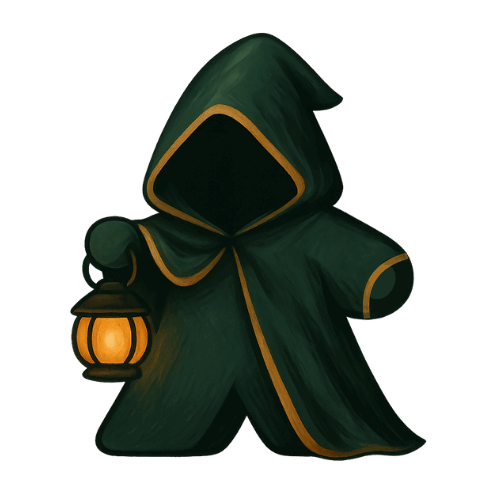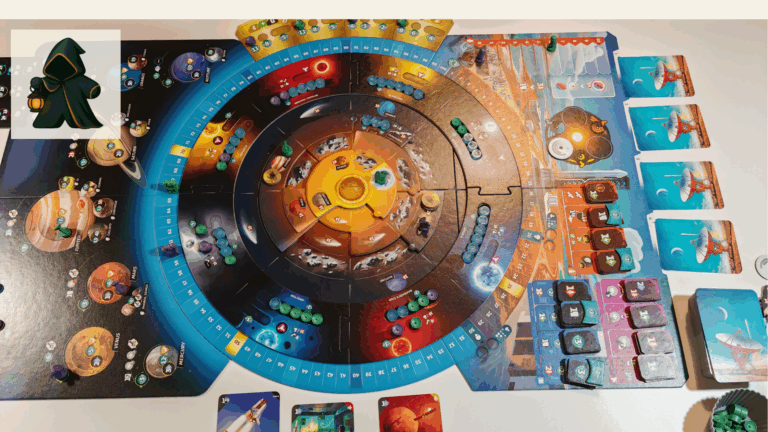Saltfjord combines simple mechanics with challenging decisions in a tight three-round game about developing a 19th century Norwegian fishing village. The game was on my top anticipated games at Spiel this year (number four) and after playing several solo games, I want to share why this thoughtful design works so well.

How to play Saltfjord
Your village starts with just a few buildings on a grid-based player board. On your turn, you’ll choose from three main actions:
1. Taking and using dice
The most common action is taking a die from the dice pool and using it to activate buildings. Here’s how it works:
- Choose and take a die from the pool
- You can pay fish to change the die’s value up or down
- Place the die above a column (white dice) or beside a row (orange dice)
- Activate buildings in that row or column in order (left to right for rows, top to bottom for columns)
- Place your die on the last building you activated, blocking it for the round
Your player board is the central part of the game. When you start, you only have a few buildings, but as you play, you’ll place more. You want to pick dice that activate rows or columns with actions you need. You need to think carefully about which building to block with your die since it can’t be used again that round.
2. Building large buildings
The second action lets you build a large building by paying wood and planks. These come in different shapes and add more actions to your board. While you can build small buildings through board actions, large buildings require using this specific action.
3. Retiring
Your final option is retiring for the round. You’ll place your marker in one of the taverns and take its action. You also get bonus actions from any trade contracts you’ve completed. If you have two trade goods in the row that has “go fishing,” you can fish twice. After retiring, you’re done for the round.
In multiplayer games, the round continues until everyone retires. But the core flow stays the same – you’re always choosing between taking dice to activate buildings, constructing new buildings, or ending your round with retirement bonuses.

Look and feel
The visual design of Saltfjord strikes an interesting balance. It’s pretty but not overstated. It’s not super colorful or crazy in anything it does. The design stays simple in its presentation, yet everything works together seamlessly.
Components and presentation
The game breaks away from typical Euro game aesthetics. It’s not your typical beige euro because it’s very blue. The color scheme creates a relaxing atmosphere that matches the game’s overall feel. The symbology works really well throughout, making everything clear and intuitive.
The wooden components add a nice tactile element. Everything from your research markers to your score track pieces comes in wood, which gives the game a solid feel.
Resource management system
The double-layered boards for resource tracking showcase the thoughtful production design. Instead of having separate pieces for each resource type, you use cubes that move between spaces on these boards. This system works perfectly because you’re constantly upgrading and downgrading resources. You don’t have to hand in one wood and then grab a plank resource – you just move the cube from wood to planks and that’s it.
Design philosophy
It feels like substantial thought went into making the game work well and flow easily. The game doesn’t rely on fancy components or special pieces because the gameplay carries it. There’s nothing special about it – no mega upgraded components, no coins or anything elaborate. But this restraint works because Saltfjord shines through its mechanics rather than flashy presentation.
The game isn’t super fancy or colorful. There’s no special super theme driving the visual design. But it still feels like a really enjoyable, fun game precisely because the gameplay is so good. This focus on function over flash serves as a compliment to the design. Everything has a purpose and supports the core experience.
The presentation maintains visual appeal while putting the focus exactly where it should be – on the engaging gameplay mechanics that make Saltfjord work so well.

How to play Saltfjord solo
The solo game maintains almost everything from the multiplayer experience. You’ll use the same actions, round structure, and board setup. The way it creates challenge and tension differs from the standard game in a few key ways.
Setup differences
The solo mode puts a strong focus on end-game scoring. At the start of the game, you’ll place four purple end-game scoring tiles on the research tracks as usual. Then you’ll take two additional scoring tiles for yourself. These personal scoring tiles create your win condition – you must score at least 10 points for each tile to win. Your total score doesn’t matter if you fail to meet these minimums.
Challenge without opposition
Instead of adding an artificial opponent, the game uses these scoring requirements to create pressure and force interesting trade-offs. You might have to make decisions that aren’t ideal because you really need specific resources or conditions to meet your scoring goals. For example, you might need that extra fish even though building would be the stronger pure strategy play.
I generally prefer having an AI opponent in solo games – someone to play against, someone who takes things away from you and creates direct competition. But for Saltfjord, the simpler approach works. In a relaxing 30-minute game, you don’t want to spend time managing an opponent. The scoring goals provide just enough extra challenge to make your decisions meaningful.
Quick playing time
While the box suggests 45-90 minutes, solo games run much faster at about 30 minutes. But those 30 minutes are packed with meaningful decisions and careful weighing of options. The designers recognized that just playing three rounds solo wouldn’t be satisfying enough. By adding the scoring goals and trade-offs, they created the extra bit of challenge needed to make it an enjoyable solo experience.
The solo mode really succeeds at maintaining the core appeal of the game while adding just enough extra pressure to make it engaging as a single-player experience. Every decision matters because you’re trying to both play efficiently and meet those scoring requirements.

What I think of Saltfjord
The three-round structure of Saltfjord creates an intense decision space. Having just three rounds means you have to be very careful with every choice. You can’t just make random moves – you have to be prepared to make sacrifices. The game length feels perfect – it shouldn’t be longer or shorter than it is.
The player board and actions
The player board activation system creates fascinating choices. You start with limited actions, so you need to quickly build more buildings to expand your options. But you can’t focus solely on building – you also need to go fishing, advance research tracks, and fulfill contracts because these all provide essential benefits.
Resource management adds another layer of strategy. Take planks as an example – you need them to build large buildings, but they aren’t easily available. You have to develop specific strategies to get planks, which means you can’t just focus on filling up your player board. The game forces you to engage with multiple systems.
Dice placement strategy
The dice system adds extra depth to every turn. When choosing dice to activate rows and columns, you have to think carefully about blocking buildings. Sometimes you don’t want to block off that last building in a row or column because you might be able to activate it with a different die later.
If the game ran for six or nine rounds, you’d eventually fill your player board, complete all your research, and fulfill tons of contracts – and that would get boring. But with just three rounds, every single decision becomes critical. You have to carefully weigh each choice against what you’re giving up.
Balance and flow
All the actions feel perfectly balanced. You need to go fishing because fish help throughout the game. You need to fulfill contracts to get those valuable retirement actions. You need everything, but you can’t do everything – and that tension makes the game work.
The game really stands out in how it creates a relaxing experience while still demanding strategic thinking. It manages to pack tons of meaningful decisions into a short playtime. The way everything connects – from resource management to building placement to action selection – creates a tight, satisfying design that works especially well for solo play.
I’m consistently impressed by how they’ve managed to put so much game into such a quick-playing package. It’s a remarkably smooth design that makes every decision feel important without becoming stressful.
Pros and cons
Pros
- Plays quickly in about 30 minutes but packs in meaningful decisions
- The player board activation system creates interesting strategic choices
- Elegant resource management with the double-layered boards and cube movement
- Clear, functional presentation focused on gameplay rather than flash
- Every action feels necessary and well-balanced
- Three-round structure makes each decision count
- Resource upgrading and downgrading flows smoothly
- Relaxing atmosphere while maintaining strategic depth
- Works great as a solo game
Cons
- Solo mode lacks an AI opponent for direct competition
- Simple visual presentation might disappoint players wanting elaborate components
- Only three rounds (though I think this is actually perfect)
- You can’t do everything you want to in a game (I think this works well)
The game really impresses with how it puts so much strategic depth into a light, quick-playing package. The designers recognized exactly what was needed to make each element work – from the component choices to the action system to the solo mode scoring goals. Everything feels thoughtfully designed to create an experience that’s both relaxing and challenging.
I think it really shines as a solo game. While some might want an AI opponent, the scoring requirements create just enough extra challenge without complicating the smooth gameplay. It’s a great example of making careful trade-offs in design to support the core experience.
Final Score: 8.5/10
Saltfjord earns an 8.5 out of 10 for packing excellent game design into a tight 30-minute package. The three-round structure hits the perfect length, forcing meaningful choices without overstaying its welcome. Every decision matters, from dice placement to resource management to building selection. The relaxing blue aesthetics and smooth component design support rather than overshadow the gameplay. While the solo mode lacks an AI opponent, the scoring requirements create just enough pressure to make each game engaging. The way everything flows together – upgrading resources, expanding your board, fishing, researching, and fulfilling contracts – shows remarkable attention to detail in the design. It’s a game that respects your time while giving you plenty to think about, and that’s exactly what I want in a solo experience.


I played 12 different 2024 releases last year and Saltfjord was my favourite.